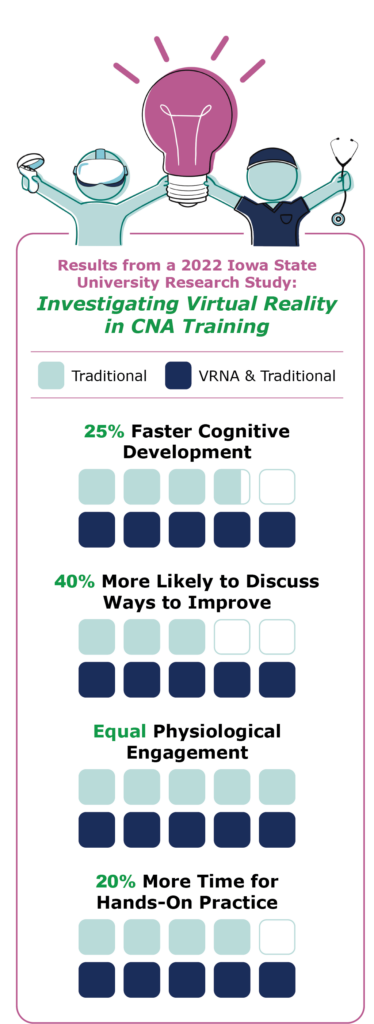- Opinion: The world of AI in CT. Why we need to consider all of it.

News
Science-Based Transformations for Nurse Assistant Training: How VR is Setting New Standards
Dernières nouvelles
- Inspiring the Next Generation of Healthcare Heroes with VRNA CNA
- Matthew Wallace Joins Connecticut Leaders to Launch AI Caucus
Dernières nouvelles
Science-Based Transformations for Nurse Assistant Training:
How VR is Setting New Standards
Recent research, from the journal Ergonomics, compares traditional nurse assistant training with a VR hybrid model to unveil compelling benefits. The study provides authoritative evidence that a hybrid education model employing VR not only accelerates learning but also enhances practical skills and knowledge retention. This evidence supports the shift towards incorporating VR technology in training programs.
These key findings demonstrate a range of practical, interpersonal, and learning benefits. These students:
- Experienced faster cognitive development
- Showed comparable physiological engagement to traditional counterparts
- Benefited from increased practice time
- Were motivated to discuss improvement opportunities with peers
These findings contribute to the development of skilled, collaborative professionals. Combined with the well-established practical benefits of virtual reality technology, the hybrid model of education proves to be an efficient and effective method of preparing skilled nurse assistants for the workforce.

Study Excerpts:
Abstract: Virtual reality (VR) has increasingly been used in several disciplines, including nursing, a profession in high demand that is now facing a shortage. This study investigated the effectiveness and efficacy of VR hybrid training over traditional training (TR) methods. Sixteen college students were recruited and randomly assigned to get 100% TR or 50% TR and 50% VR (VR50). Participants attended a three-day program with a registered nurse, consisting of lectures and practical lab sessions. Participants’ performance, training time, cognitive development, physical development, mental workload, user experience, Students’ Satisfaction and Self-Confidence, and team learning were evaluated. The results showed that the VR50 performed as well as, and sometimes even better than the TR group (p-value = 0.043). VR50 group significantly had higher cognitive development and found VR easy to use and attractive (p-value < 0.05). VR-integrated training makes nurses’ training more affordable and accessible while providing instant and relevant feedback.
Stone, R. T., Mgaedeh, F. Z., & Pulley, A. N. (2024). Cognitive and physiological evaluation of virtual reality training in nursing. Ergonomics, 1–13. https://doi.org/10.1080/00140139.2024.2337842
Practitioner Summary: This study assessed employment-integrated virtual training in nursing, particularly peri-care, by comparing the performance, cognitive, physical, and mental workload of traditional and integrated VR training groups. The findings of this study provide significant support for incorporating VR training into educational settings.
Conclusion: In light of the overall shortage of healthcare professionals, particularly nurses, there is a pressing need to identify an efficient approach that may expedite the training of skilled and capable nurses while considering factors such as time, cost, and quality. To this end, this study evaluated the use of VR technology vs traditional training. More specifically, this work utilizes a within-study approach to examine the effectiveness and efficacy of VR training technology in hands-on medical training. Performance, cognitive development, physical development, MWL, UE, Students’ Satisfaction and Self-Confidence, training time, and team learning were assessed. Compared to the traditional training methods, this research has demonstrated that training incorporating VR leads to more significant cognitive development.
Additionally, the VR-integrated training demonstrated a superior experience for the VR50 group compared to the TR group. This study provides evidence that traditional training CNAs be replaced with VR-integrated training to achieve performance outcomes comparable to, and in some cases even superior to, those achieved through traditional training. The lack of identifiable distinctions in the physical development, MWL, and subjective levels of satisfaction and self-confidence among students suggests the potential efficacy of VR-integrated training as a promising approach for peri-care training.
The primary benefits of incorporating virtual VR into training encompass the empowerment of instructors, heightened learning effectiveness, promoting equitable learning opportunities, and reducing program costs. The overarching objective is to enhance the effectiveness and cost-efficiency of teaching CNA job skills, traditionally conducted in a laboratory setting. The contribution of this paper is (1) a validated immersive VR technology to train peri-care skills for CNAs and (2) a promising result to extend the testing and application of VRNA for other CNA skills.

For more information about VRSim products that employ the same VR methodologies used in the study, visit VRNA.net
With special thanks to the authors, educational staff, and supporters:
Richard T. Stone, Fatima Z. Mgaedeh, Alexandria N. Pulley, Kay Landon RN, Maggie Volz, the Center for Industrial Research and Service (CIRAS), and Iowa State University.
